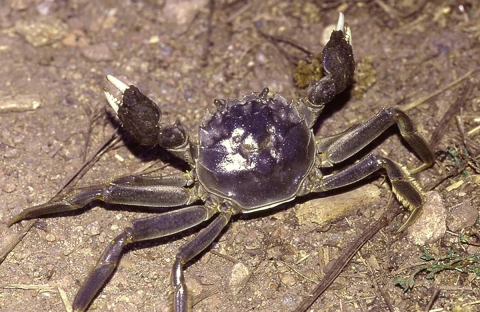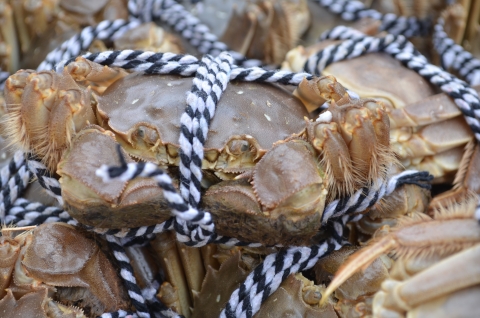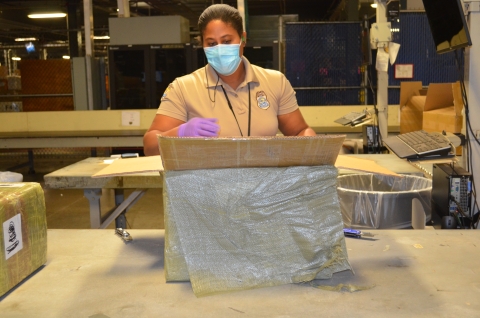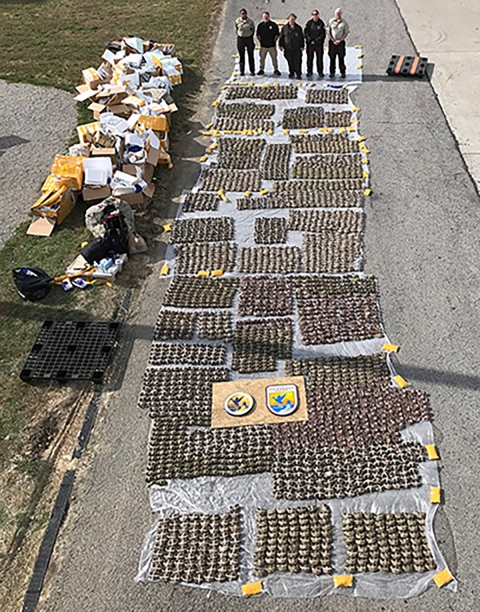Sounds like a spoof horror flick, doesn’t it? Unfortunately, hairy clawed crustaceans have been transported out of their native Asian waters and have invaded North America and Europe. They are better known as mitten crabs (Eriocheir sp.).
Mitten crabs are medium-sized burrowing crabs native to Asian rivers, lakes, and coastal habitats. They have dense amounts of setae (bristle- or hair-like structures) covering their claws causing them to resemble mittens, thus the name. They sound cute, but their introduction to U.S. ecosystems can cause serious harm.
In 1989, live mitten crabs were listed as injurious wildlife under title 18 of the Lacey Act. They are prohibited from being imported into the United States and can be a hazard to natural resources, the economy, and human health. Mitten crabs can outcompete native species for food and space and their “mittens” can transport hundreds of tiny nuisance organisms. Their burrowing activity can cause damage to levees resulting in significant erosion. They can damage industrial plants by causing filter screens, pumps, and water intake structures to fail and can also have a serious effect on the commercial fishing industry. These crabs are known to host the oriental lung fluke, and other zoonotic organisms, which can be transferred to humans in raw or undercooked crab meat. In the United States, mitten crabs have been found in several areas including the Great Lakes, Chesapeake Bay, Delaware Bay, Hudson River, Mississippi River, San Francisco Bay, and the Columbia River.
Mitten crab season begins around September 1, coinciding with the female crabs’ roe maturation, running through December, and often into the new year. In some cultures, the crabs are a food delicacy, and this desire creates a lucrative market, which drives the black market smuggling of live mitten crabs from Asia into the United States every year.
The U.S. Fish and Wildlife Service’s Wildlife Inspection Program is the nation's front-line defense against the illegal wildlife trade. The program consists of specialty-trained wildlife inspectors who work alongside of other Federal Government law enforcement officers to protect our nation’s resources. They are a vital component of the “One Government Approach” that protects our nation at its ports of entry.
Wildlife inspectors help the United States fulfill its commitment to global wildlife conservation by interdicting illegal shipments of smuggled wildlife and wildlife products, preventing the introduction and spread of invasive species invasive species
An invasive species is any plant or animal that has spread or been introduced into a new area where they are, or could, cause harm to the environment, economy, or human, animal, or plant health. Their unwelcome presence can destroy ecosystems and cost millions of dollars.
Learn more about invasive species , and facilitating the multibillion-dollar legal wildlife trade.
In 2019 and in the fight against wildlife trafficking, the Service created the Wildlife Inspection Interdiction Team (WIIT). Operation Hidden Mitten was its first international inspection operation, which was focused on live mitten crab smuggling. The team consists of seasoned Service law enforcement professionals who are committed to closing international wildlife trafficking pathways, generating intelligence, and coordinating national wildlife inspection efforts.
Each fall, wildlife inspectors search for live mitten crabs being smuggled into the United States. Annually, and under the leadership of the WIIT, tens of thousands of live mitten crabs are interdicted from illegal shipments. To evade law enforcement, smugglers have falsely declared the shipments as items such as T-shirts, jeans, auto part samples, shopping bags, photo albums, and other commercial products.
You can do your part to help stop these invaders from entering our country. If you see live mitten crabs in the marketplace or in our waterways, please contact the U.S. Fish and Wildlife Service by calling toll free at: 1-844-397-8477.
Reward information:
The U.S. Fish and Wildlife Service is authorized to pay rewards for information or assistance that leads to an arrest, a criminal conviction, civil penalty assessment, or forfeiture of seized property. Payment of rewards is the discretion of the Service and is linked to specific federal wildlife laws. The amount of any reward we may pay is commensurate with the information or assistance received. Please discuss the possibility of receiving a reward with the Service personnel receiving your information or assistance.
This story is from our Open Spaces blog.









